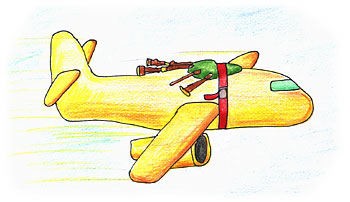  |
||
 |
 |
 |
 |
 |
||
| reference articles | competition journal | piping links | FAQ | contact me |
Andrew's Tips: Traveling on Airlines with BagpipesBy Andrew T. Lenz, Jr., Santa Cruz, California, ©2006-2023
You are planning a trip and are hoping to play your pipes in an exotic location—be it Scotland or Aunt Gertrude's backyard. Since it'll be a new experience, you are a bit trepidacious about getting through security checks and getting on-board with your pipes. Here are some guidelines for traveling the skies with your pipes. IMPORTANT RULE #1: NEVER check your pipes though into the cargo hold! Luggage holds on many aircraft are not heated and temperatures can drop to below freezing—not good for wood pipes! Plus you've probably seen those guys throwing those suitcases onto those conveyor belts, right?
Honestly, flying with your bagpipes in a backpack and checking through your "bagpipe-less" pipe case is the easiest and most foolproof method of travel. However, flying with your pipe case nearby isn't all that complicated, I've done it many times. If your pipes are particulary special to you (like an heirloom), consider flying with a different set of bagpipes. And if your pipes are replaceable but very valuable, consider purchasing temporary insurance. (An appraisal of your bagpipes may be necessary, my article on bagpipe appraisal may help.) Measure your pipe case then check with your airline as to the carry-on size limitations—if it is, your trip will be relatively easy. (Checking may be a trip to their website or a call to their agent.) Depending on the airline, a "pipe major's case" (extra long) may exceed a particular airline's size limitations for carry-ons, but a regular size case is typically fine. You can always see if a different airline and/or flight has larger carry-on limitations. If your case exceeds the normal limits, ask an agent what your options are other than checking your case though (such as the coat closet)—but there may not be any other options for that particular pipe case. An easy alternative is to transfer the pipes into something temporary, such as a backpack or soft satchel. It would be wise to bring such a carrier along because, even after all your precautions, you may still be told at the gate that your case is too big to carry on. Once your pipes are removed—unless you have something breakable or freezable still inside—your case should be able to be safely checked-though. (Keep in mind that some airlines may charge you extra for stowing another piece of luggage if you are already stowing the maximum number of pieces without including your pipe case.) You might also consider a strap around your pipe case rather than trusting two small clasps—and though you may be tempted, avoid locking your clasps because if something appears suspicious in your case when scanned or X-rayed, the clasps will be broken in order for security agents to gain access. (Even a stack of chocolate bars may appear to be plastic explosive!) If your case is under the maximum dimensions but it constitutes an extra carry-on beyond the normal quantity limit—say three carry-ons instead of two—contact the airline and explain the situation, that is, you are hoping to carry on a musical instrument case of such-and-such a size. Most airlines don't allow an extra carry-on just because it is a musical instrument. If you do manage to get permisison for an exra carry-on, make sure you get that permission in writing and bring a copy with you. Even with that, it's wise to plan for still being denied. Airlines are not allowed to charge you extra if your carry-on just happens to be a musical instrument. If you opt to buy a second seat (one for you, one for your instrument), the airline is not allowed to charge you a higher ticket price for the instrument. You can read more about it here, hosted on the American Federation of Musicians website: FFA Musical Instrument Carry-on. A U.S. airline does have the authority to deny a carry-on for a musical instrument due to lack of space or in the interest of passenger safety (see Section 403): I'd recommend reviewing the American Federation of Musicians' Travel Kit, which provides information and links pertaining to flying with instruments. Also keep in mind that if at any point you are changing planes to a smaller regional-sized aircraft, the carry-on limits may shrink dramatically. Be sure to check for this. Now on to some other preparations! Remove any sharp instruments from your pipe case. Yes, this means pocket knife, scissors, razor blades, sgian dubh, dirk, etc. Those items you can move to your check-in luggage prior to the airport. In 2006, quantity restrictions on liquids were implemented. This would include bore oil, hand cream for your electronic bagpipe, sunscreen, and other similar items that you might be taking with you. If your pipes have room to move around inside their case, consider padding them with a towel or a sheet of foam. Also consider completely disassembling your pipes. They'll likely be fine, but joints may tighten up due to the pressurization in the cabin. Put your complete contact information in your case clearly identifying you as the owner of the pipes. On the outside, attach a luggage I.D. tag to the handle of your case. It might be wise to include "care of handling" along with your contact information instructing the recipient of your pipes to not subject them to extremes and that they are fragile. Heaven forbid that you'd leave your pipes on the plane or someone else might grab them thinking they are their prize oboe, but who knows. One-too-many overpriced airline 'drinky-poos' and it's all over. (I'm sure it's the oboe player and not you!) If you are heading to a country that doesn't speak your native language, you might consider taking a photo of a piper—ideally, you—playing bagpipes to help explain what these possibly dangerous wooden tubes are used for. If you are taking an electronic bagpipe/practice chanter, make sure it has functional batteries in case you are asked to play it. Also remember to keep earphones with it at all times! Avoid transporting such an electronic device in a PVC pipe (as recommended by some) since this combination may look like a pipe bomb to a screener and, in fact, one such configuration shut down and evacuated a whole airport in Portland, Maine on January 13, 2004! It's not a bad idea to move any electronics (metronomes, tuners, electronic musical instruments) into your stowed luggage.
If you want to be particularly careful, take a mobile phone photo of your pipe case open and in the airport right before your flight. The data and location metadata stored with the photo will prove very useful in the event of damage to your pipes by the airline. Sometimes, after having your pipes/electronic instrument X-rayed, you might get to enjoy a brief chat with an airport screener. (Sometimes, however, the encounter may not be so brief, so you may wish to arrive at the airport a little earlier.) I've flown with an electronic DegerPipes many times and have only been asked a couple of times what it was and I suspect that those questions were more out of mild curiosity than professional concern. As for pipes, I do recall a story of a piper being instructed to play his pipes to prove that they were not a weapon; only after the supervisor ran over and stopped the piper from striking in was the screener convinced. This is highly unusual. My pipes have been regularly ignored by the X-ray technicians and once I was even asked: "Bagpipes?" When your pipes are being scanned, keep an eye on the operator. If he or she starts looking concerned by what's on the screen, you might do well to lean forward with a quick: "They're bagpipes." In any case, if the officials say they have to take your pipes for inspection, do your darndest to not let the pipes leave your sight. Aside from possible rough handling, the last thing you want is for them to check your pipes through without telling you. Or, ok, worse yet, slipping them out the back door to their buddy—though that's even more unlikely. If an airline official insists on moving your case (with your pipes inside) to check-though luggage—violating Important Rule #1—ask to speak to the supervisor. If you are forced to check your pipes—did you forget your backup pipe carrier?—whatever you do, refuse to sign any release. Once you've signed that release, you have virtually no legal recourse if your pipes are damaged. Really, the question should be: "Is this flight worth destroying my pipes by checking them through?" Often, it's no. Either transfer them to a different means of carrying them on the plane (with no hard case) or simply don't take the flight. Boarding When you get to the gate, talk to the agent at the desk and explain that you are traveling with a fragile set of bagpipes in your carry-on case. Ask to board as early as possible. Sometimes, they will let you board with the passagers "needing extra time boarding". (If you wish to assure that you will be able to find room for your pipe case, purchase a priority boarding ticket when you book your flight.) While boarding, if any flight personnel try to keep you from stowing your carry-on, stay calm. Ask to see the supervisor. Push comes to shove, take your pipes out of the hard case and move them into that backpack or bag that you brought just in case, right? While Flying Watch out for that one-too-many drinky-poo, you don't want to grab an oboe case by mistake. Seriously, after your preparations, once you are on the plane, you are in great shape, the rest should be easy. Damaged Pipes? If your pipes were forcibly checked through into the cargo hold, inspect your pipes immediately when you retrieve them from baggage claim. If the airline damaged your pipes, go immediately to the airline baggage office nearby and fill out a claim before you leave the airport.
Enjoy your trip!
If you have comments or suggestions about this page, please contact me. This page last updated Sunday, July 30, 2023. |
| sitemap | ||


